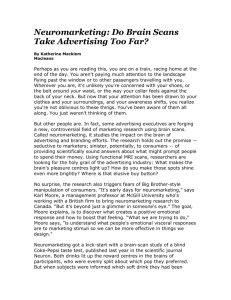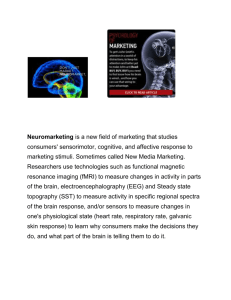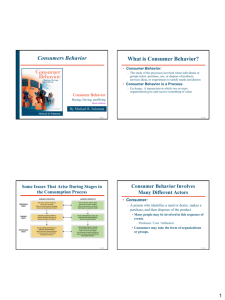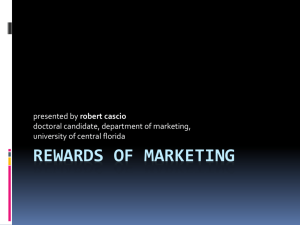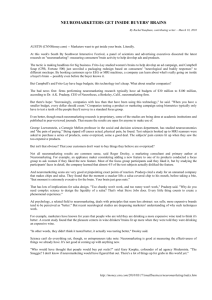[
advertisement
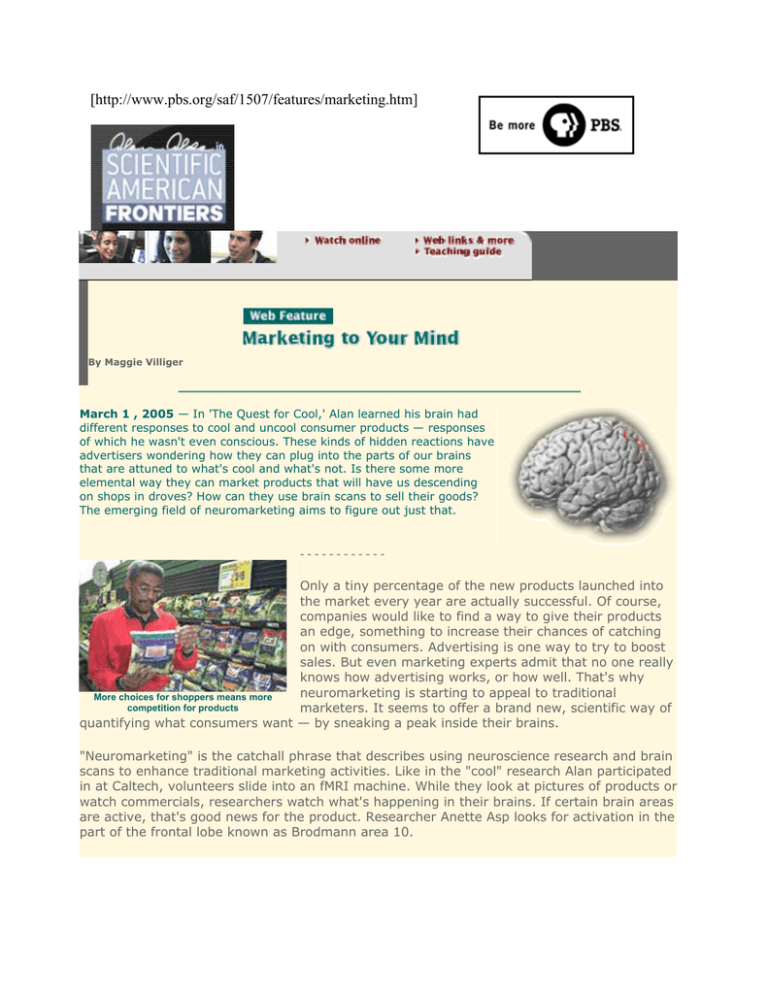
[http://www.pbs.org/saf/1507/features/marketing.htm] By Maggie Villiger March 1 , 2005 — In 'The Quest for Cool,' Alan learned his brain had different responses to cool and uncool consumer products — responses of which he wasn't even conscious. These kinds of hidden reactions have advertisers wondering how they can plug into the parts of our brains that are attuned to what's cool and what's not. Is there some more elemental way they can market products that will have us descending on shops in droves? How can they use brain scans to sell their goods? The emerging field of neuromarketing aims to figure out just that. -----------Only a tiny percentage of the new products launched into the market every year are actually successful. Of course, companies would like to find a way to give their products an edge, something to increase their chances of catching on with consumers. Advertising is one way to try to boost sales. But even marketing experts admit that no one really knows how advertising works, or how well. That's why neuromarketing is starting to appeal to traditional More choices for shoppers means more competition for products marketers. It seems to offer a brand new, scientific way of quantifying what consumers want — by sneaking a peak inside their brains. "Neuromarketing" is the catchall phrase that describes using neuroscience research and brain scans to enhance traditional marketing activities. Like in the "cool" research Alan participated in at Caltech, volunteers slide into an fMRI machine. While they look at pictures of products or watch commercials, researchers watch what's happening in their brains. If certain brain areas are active, that's good news for the product. Researcher Anette Asp looks for activation in the part of the frontal lobe known as Brodmann area 10. Alan Alda's Brodmann Area 10 lit up when he saw certain types of products. That part of the brain is used to reflect on yourself and how you might be viewed by others — and it often lights up when subjects imagine themselves using the particular product on display. "I think that's an interesting result," Asp says. "You don't just buy a product for its own sake, isolated from the rest of your world. It's actually a very social act and we're showing the world who we are by buying these products." Consumers take a lot more into account when they decide to buy products than dry economic theories of utility and cost might suggest. It's early days for neuromarketing. Practitioners are still figuring out just how to integrate the brain scan technology with marketing ideas. Right now it seems to be most useful for products that have big fashion or design components — things like cars, consumer appliances, and furniture. Researchers can show volunteers several brands of MP3 player, for instance, and see which one elicits the biggest brain response. Then the manufacturer can see how their MP3 player compares with the competition. Another way to use the neuromarketing concept is to present volunteers with several versions of a logo or a package design; manufacturers can get feedback on which variation consumers prefer before launching a new product. The technique may be quite useful when movie studios are figuring out which version of a film trailer would be most effective — movie previews are ads where the content is very closely related to the product itself. How do other MP3 player brands stack up against the Ipod? Why are marketers so captivated by the possibilities of this new field? Basically because it's another technique they can add to their toolkit — and there's the promise that they'll be able to glean additional information from volunteers. Right now, traditional marketing relies heavily on focus groups. Consumers are presented with an ad or a package design or a logo and then asked questions about how much they like it, whether they might consider buying it, and so on. But this kind of research has Focus groups are a mainstay of traditional marketing efforts. some notorious downsides: sometimes people provide the Credit: Prairie Research Associates answer they think the investigator wants to hear. Sometimes Inc. there's one loudmouth in the group who, through example, influences everyone else's opinion. Other times a volunteer might be embarrassed to provide his real opinion. "There can be socially acceptable and socially unacceptable answers," says Tim McPartlin, Senior Vice President at Lieberman Research Worldwide. "Let's say it's an ad that features a girl in a bikini. Now maybe the respondent likes that but they don't want to tell the female interviewer that they like that. So they may say it's not particularly appealing — which isn't their true opinion." Perhaps most surprising is that sometimes people aren't even aware of their own feelings about a product. Reactions can be unconscious. Using the fMRI, researchers can peer into the volunteer's brain and discern a reaction, without waiting for the volunteer to formulate a conscious response. "The questions a marketer asks his subjects, they consciously have to reflect on," says Asp. "I sometimes think they force an answer just because they feel they're expected to say something. So they form an opinion as they answer the question, while we're more or less reading their minds. With the brain scans we're able to pierce inside their conscious mind to their unconscious motives and reactions to things that marketers might not be able to reach." McPartlin thinks of it as a way to get past what might be considered a socially acceptable response to the subject's true opinion. "I can ask you directly 'how much do you like this?'" he says. "And you say 'I don't particularly like it.' But if I can see your brain activity and parts of the brain that suggest you really, really like it, then I've got some more information. It's just a better measurement." FMRI scans capture unconscious reactions Scantily clad women and trucks are a time-honored advertising motif But what does that "better measurement" really tell you? Are we more likely to buy things to which we have these strong unconscious reactions than things we profess to be attracted to? At this point, no one is sure. "I don't think there is ironclad proof that you will act on what we see in the brain scans," says McPartlin. "The hypothesis is that if I can get a truer and more accurate reading of my customers' opinions, I'll know better whether they will buy it. It seems to make sense." Pilot tests are underway to do things like correlate how much people say they like a snack food package or a TV commercial with how active their brain scans look. It's all rather murky right now. And researchers are having a tough time nailing down what personality traits or other factors might unite the groups of people who respond very strongly to particular stimuli. Some critics don't like the sound of all this talk about seeing inside brains to our true preferences. They worry that marketers will gain too much power over us — citing the so-called "marketing-related disease" of obesity and all the health problems that accompany it. They worry about political propaganda that could speak directly to our hidden minds in ways of which we might not even be conscious. They paint ominous pictures of manipulated consumers and voters in an Orwellian future. Brain Critics say some advertising promotes researchers respond that these concerns are more science fiction than unhealthy habits and reality; the scans are narrowing in on people's natural reactions, not contributes to the obesity epidemic implanting drives or desires. And their level of resolution is far too crude to read specific thoughts or urges at particular moments; the scans can only offer a broad understanding of a reaction to one object in comparison to another. There may be a protective aspect to the brain scan/product studies as well. As Dr. Read Montague, a neuroscientist at Baylor College of Medicine, puts it, "The question is, isn't this research going to give slickster, unctuous marketers more power to make us buy more crap we don't want? But it's the opposite." Montague argues that currently we do not understand the covert ways that advertising works on us. By providing more knowledge of how our brains react to certain kinds of images, stories and ads, he believes that these studies empower consumers. If we discover that certain ways of delivering a message bias people in its favor, consumers can presumably guard themselves against those methods. And there are implications for minors too. "We suspect that marketing to children is unfair," says Montague. "Somehow children aren't quite culpable, aren't quite independent enough agents to be able to make what we consider to be rational choices in what they eat or don't eat, for example." But why exactly is that, what is happening — or not happening — in their brains? We don't understand yet what changes between when a child is 8 and when he turns 18 — and Montague says we won't unless we take a close look at their brains. In Anette Asp's native Sweden, advertising to children is illegal; greater understanding of children's susceptibility could lead to restrictions here. Neuromarketers use brain science to "read the minds" of their subjects; then they use the information they glean to refine their products and ads into more attractive forms that they hope will help sales skyrocket. "Companies try to make products that appeal to the people who buy them," says marketing expert McPartlin. "That's a time-honored tradition in our capitalist society, nothing strange or unique about that." It's the addition of cutting-edge brain science to the mix that makes this a most modern type of marketing. Children seem to be especially influenced by advertising and what they watch on TV
